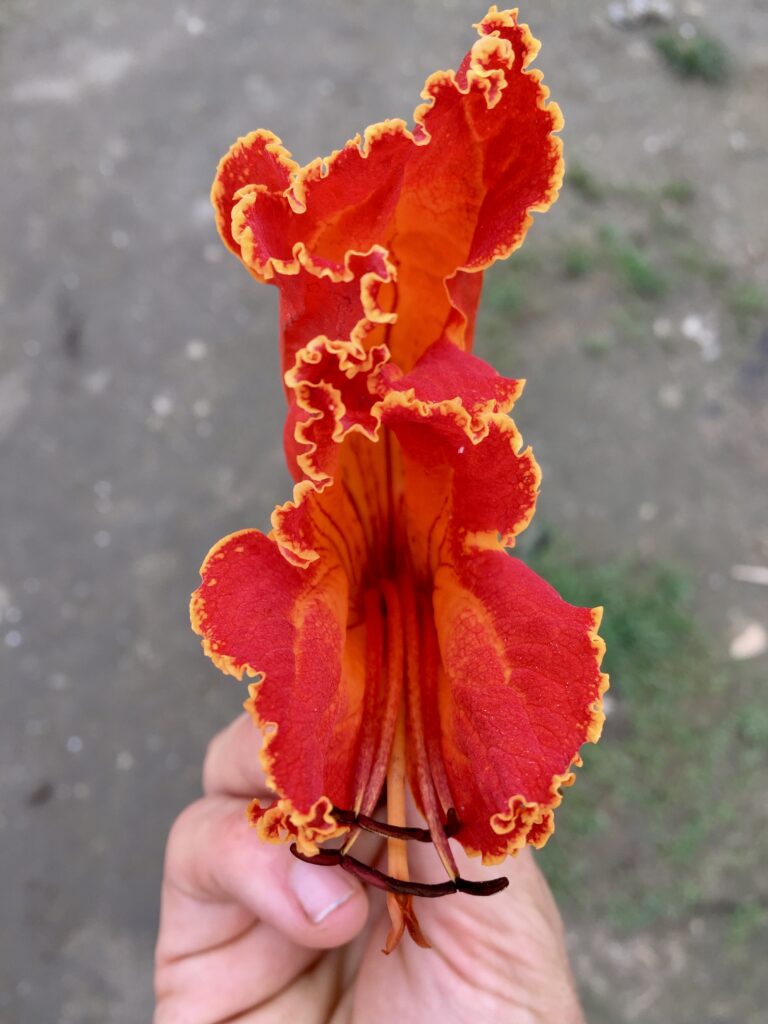Tulipán, also known as African tulip tree or Llama del Bosque, is in the Bignoniaceae family and is native to the tropical dry forests of Africa. It is cultivated extensively throughout the tropics and is well-loved for its showy reddish-orange flowers. In Guatemala, it is grown as shade trees on coffee plantations.
Tulipán has a number of medicinal applications. It has been said to be used for epilepsy, kidney disease, inflammation of the urethra, and as an antidote for animal poison.
A decoction of the leaves is used for pain, inflammation, constipation, and dysentery, a type of bacterial gastroenteritis that results in bloody diarrhea, fever, and abdominal pain. A decoction of the stem is used to treat fungal skin issues, herpes, eczema, stomach pain, and diarrhea. The plant also has analgesic and anti-inflammatory properties (Adeneye).
A 2009 study published in the Asian Journal of Medical Sciences found that the alcoholic leaf extract of Spathodea campanulata has significant anti-inflammatory and analgesic effects (Illodigwe).
Tulipán contains constituents that have anti-parasitic, antimalarial, and antimicrobial properties (Noguera).

Despite having a variety of potential medicinal uses, research has found that Spathodea campanulata does cause “subchronic toxicity,” which is defined as adverse effects occurring after the repeated or continuous administration of a substance. One particular study found that giving rats varying oral doses of an alcoholic extract of the leaves daily for 90 days caused “dose and time dependent hepatotoxicity” as well as decreased consumption of food & water, muscle weakness, emaciation, and sluggishness. These symptoms did completely resolve, however, 28 days after researchers stopped administering the extract (Adeneye).
Tulipán has also been shown to be an effective insecticide. A study involving various insect pests of Guatemalan coffee, ficus, corn and fruit crops found that the leaf and flower extracts of Spathodea campanulata did have an insecticidal effect on most of the insect species studied. Additionally, the fresh leaves and flowers had a repellent effect on corn weevils (Noguera).
Research has also demonstrated that a flower & leaf extract was an effective insecticide against the “broca del café,” a pest that negatively affects coffee quality and yields in Guatemala. Specifically, the extract killed 60-80% (dependent on the strength of the solution used) of the coffee borers within 72 hours of application (Alarcon-Noguera).
Tulipán is commonly planted as an ornamental tree in parks and along roadsides throughout Ecuador and seems to thrive in the country’s many different micro climates— from the north, in and around Quito, to the coast, as well as here in Southern Ecuador. While tulipán is usually planted for its beauty alone, its numerous medicinal and practical uses make it a valuable addition to gardens, parks, and landscapes throughout tropical regions of the world.
References
Adeneye, Adejuwon Adewale. 6.7.2 Spathodea campanulata P. Beauv (Bignoniaseae). “Subchronic and Chronic Toxicities of African Medicinal.” Toxicological Survey of African Medicinal Plants, 2014.
Alarcón-Noguera, R; Penieres-Carrillo, G. Evaluación in vitro de extractos de hojas y flores de llama del bosque (Spathodea campanulata B.) sobre la broca del café (Hypothenemus hampei F.). Tecnología en Marcha. Vol. 26, Nº 3. Pág 39-49. 27 de noviembre del 2012.
Noguera, Alarcón and Reynaldo Humberto. Efecto insecticida, repelente y fungistático de extractos de hojas y flores de Llama del bosque (Spathodea campanulata. Universidad Estatal a Distancia CR. 2014.

